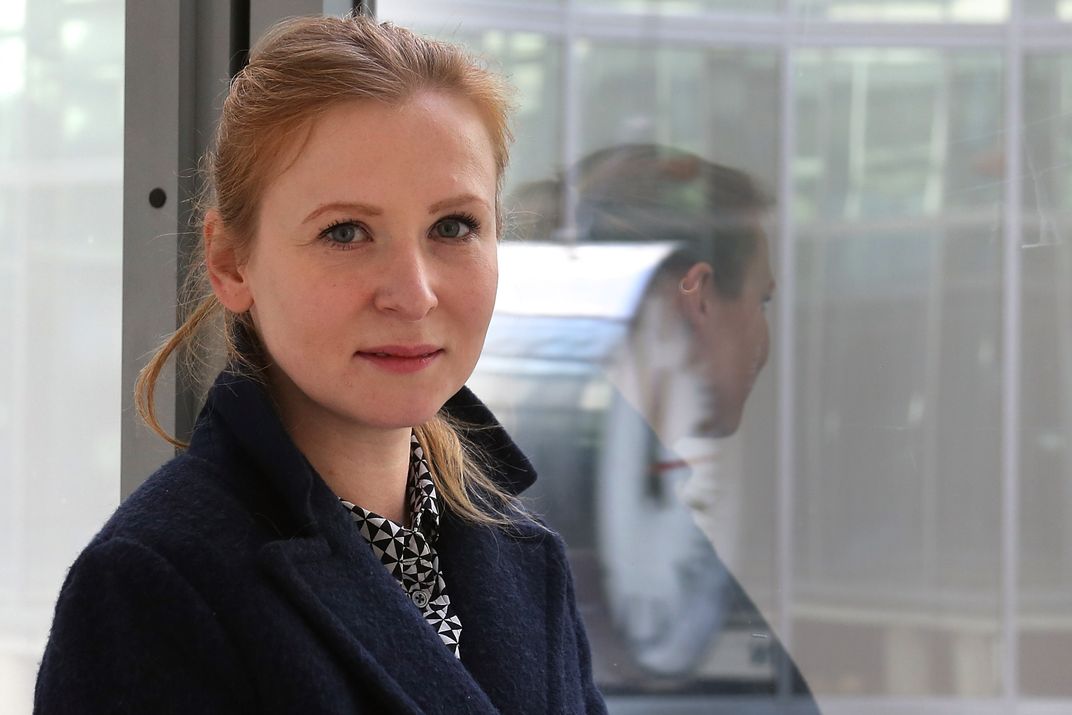Alicja Kwade’s Installation at the Hirshhorn Invites Viewers to Question the World as We Know It
The visually immersive artwork is a recent acquisition now on view in a new exhibition
/https://tf-cmsv2-smithsonianmag-media.s3.amazonaws.com/filer/06/5d/065d9fe2-36fa-4b65-9554-cbcd951c890f/dsc05186.jpg)
Alicja Kwade’s installation WeltenLinie is full of dualities. It is simultaneously structured and whimsical, sensible and illusory. This is a reflection, she says, of the human need to systematize the unknowable.
“It’s a kind of tragic thing to be a human being because we are trying so hard to understand the world, but actually, there is no chance,” says the Berlin-based artist. “We are building systems, political structures or religions to make this doable and as easy as possible to survive in it. Actually, it’s a bit absurd.”
Precise and mathematical, Kwade’s art reflects her affinity for philosophy and science. She studies Marx and Kant, and reads quantum physics in lieu of fiction. The Hirshhorn museum's chief curator Stéphane Aquin describes her as “an amateur historian of science.” Kwade’s curiosities are reflected in her work, which tends to pose hard questions about our relationship to objects and the universe, while creating a space for the viewer to ponder the answer.
“It’s about thinking how we describe the world, how we define objects—where they end and where they begin and what the transformations of them could be,” Kwade says. “But not just physical transformation or chemical transformation, but also the philosophical or social transformation.”

To walk around Kwade’s large-scale installation WeltenLinie, meaning “world lines,” is like passing into some strange new dimension. The visually immersive, steel-frame structure is a recent acquisition to the collections of the Smithsonian’s Hirshhorn Museum and Sculpture Garden and is now on view in the exhibition, “Feel the Sun in Your Mouth.”
For this show, assistant curator Betsy Johnson united works acquired by the Hirshhorn over the past five years. The exhibition mixes pieces from the 1960s and 70s with recent works. They hail from a dozen different countries and bring fresh light to contemporary issues. The museum says the show aims to “[harness] metaphor and suggestion to create meanings that exist outside language.”
Jesper Just’s Sirens of Chrome is a suspenseful, dialogue-free video that follows several women through the streets of Detroit. Japanese artists Eikoh Hosoe, Minoru Hirata, Miyako Ishiuchi, Koji Enokura and Takashi Arai show moody photographs depicting postwar Japan. Laure Prouvost’s Swallow and works by Katherine Bernhardt and Jill Mulleady burst with color and sensation.
By contrast, Kwade’s installation is neat and serene. Set in an all-white room and accompanied by Tatiana Trouvé’s similarly large-scale and unassuming Les Indéfinis, WeltenLinie feels accessible, yet enigmatic.
Tree trunks made in varying sizes and constructed of plaster, copper and aluminum create an eclectic kind of forest. Large metal rods frame double-sided mirrors and plain air, at times splicing differently colored tree trunks and playing tricks with the mind. The trees seem to move with the viewer, disappearing at the edge of one frame only to reappear when passing before the next reflective surface. In this space, Kwade encourages the viewer to forget the forest for the trees.
“What is defining a tree? What can I know about this tree?” Kwade said in a conversation with Aquin last week. “I can know all of its chemical structure, I can know that it’s growing, but what is our way to describe it? And what could it be like seeing it from the other side?”
Kwade was born in Communist Poland in 1979 and escaped with her family to West Germany at 8 years old. Though she doesn’t seek to make art about her experiences on both sides of the Iron Curtain, she concedes they informed her perception of differing political and social structures from a young age.
“I was raised in a completely different parallel world. This was a very different normality which then immediately was changed to another one,” Kwade says. “I was the last generation to experience both these systems.”
Her art frequently includes mirrors, allowing an object seen on one side of a barrier to be completely transformed when viewed from the other. She says she wants viewers to consider the many possibilities for a single, seemingly common object.
Once Kwade has conceptualized a piece, she scans the central objects. She then digitally manipulates them, smoothing out the bark of a tree or removing its limbs, in the case of WeltenLinie. On her computer, Kwade develops models of the finished project, virtually inspecting it from every angle. Once complete, she passes her instructions along to the production team, which builds the sculptures.
“I am satisfied if I have found the clearest way to express what I want to express,” Kwade says. “Everybody can see it is what it is.”
For WeltenLinie, Kwade duplicated her computer-generated version of the tree using plaster, copper and aluminum. She says she selected materials humans use “to build our own reality” to probe the relationships between nature and industry.
This conceptual line can be traced throughout her work. In ParaPivot, currently on display at the Metropolitan Museum of Art, Kwade sets planet-like stones into metal frames that evoke the systems and structures we assemble to make sense of the universe. In other works, she transforms functional objects like her phone, computer and bicycle into new objects by pulverizing, twisting or otherwise re-constructing them. In everything she creates, one detects a mathematician’s precision and a poet’s insight.
“Feel the Sun in Your Mouth” is on view at the Hirshhorn Museum and Sculpture Garden until February 23, 2020.
/https://tf-cmsv2-smithsonianmag-media.s3.amazonaws.com/accounts/headshot/IMG_1578_copy_copy.jpg)
/https://tf-cmsv2-smithsonianmag-media.s3.amazonaws.com/accounts/headshot/IMG_1578_copy_copy.jpg)